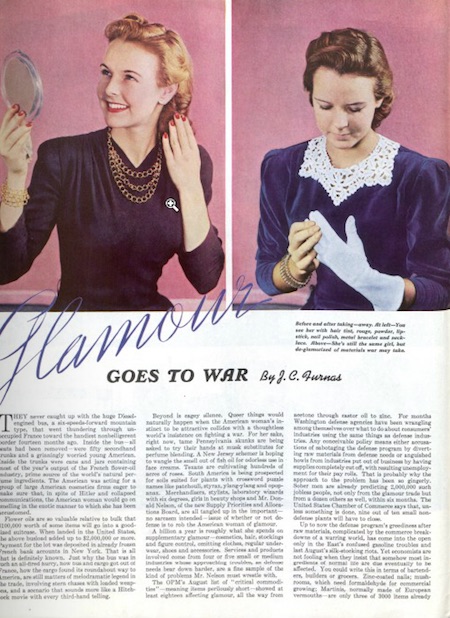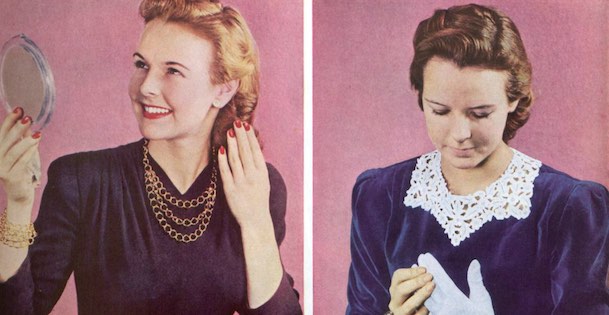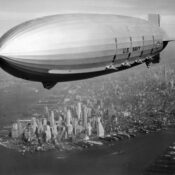By the time Americans entered World War II after the attack on Pearl Harbor, they had already been feeling the effects of shortages.
Gas was still available in the fall of 1941, but gas stations were reducing their hours of operation to help conserve energy.
New cars weren’t in short supply yet, but automakers were reducing their production of passenger cars to build more airplanes and tanks. Businesses were warning Americans to take better care of their cars because it might be a long time before they could be replaced.
Of all the industries affected by the war, though, none brought the effect of war closer to Americans than the glamour business.
As J. C. Furnas points out in his November 29, 1941, article, “Glamour Goes to War,” American women were coping with shortages of cosmetics and stockings well before 1941. Embargoes and blockades halted the export of essential perfume oils from France, Bulgaria, Tibet, and Zanzibar. Necessary ingredients for lipstick and hair dye were no longer available from warring nations. Chemical solvents in nail polish were being requisitioned for military purposes. Even the brass used for lipstick containers was in short supply.
Almost all available silk had been purchased by the Defense Department to make parachutes and tents. Nylon stockings should have been the economical alternative. They had been introduced in May 1940, and 64 million pairs had been sold within the first year. But the raw materials of nylon were being used in the war effort, and women who wanted to avoid a bare-legged look were painting seams up their calves.
When the military began buying up the market supply of textiles, the fashion industry responded to the shortages by using less fabric in dresses. Hemlines went up and unnecessary detailing was dropped.
When cosmetics began to disappear, there was no matching movement to cut back on lipstick and powder. European perfume ingredients were replaced with synthetics, and whale spermaceti used in lipstick was swapped for more domestic lubricants.
Women continued to pursue the conventionally feminine image, even when operating heavy machinery in a B-17 plant. Advertisers encouraged this attitude, telling women it was their patriotic duty to maintain their looks for their men in uniform. The author himself warns that “many women, deprived of the usual makings of charm, would lose the personal self-confidence that helps bolster them through the ills of life.” The thought of 40 million women “reverting to Nature” made everyone jittery.
Much of the article is addressed to the “man of the house,” suggesting that his wife shouldn’t panic over the shortage. She may not have heard his reassurances, having already left for work at the munitions plant.

Featured image: Photos by Constance Bannister for “Glamour Goes to War,” from the November 29, 1941, issue of the Post.
Become a Saturday Evening Post member and enjoy unlimited access. Subscribe now




Comments
I agree. For several months after I was discharged from the military I
continued to wear parts of my uniform because manufacture of ordinary
women’s clothing was not yet up to speed.
This was a very fascinating article to me. I’d always been aware of shortages of rubber and steel during World War ll, particularly after the U.S. entered the war after 12/7/41. Cars stopped production in early 1942, with the last ones being known as ‘black out’ cars, final stripped/no frills models before the complete conversion to fighter planes, and other necessary wartime killing machines by the U.S. automakers until 1946.
It’s a common mistake (I know I’ve made it) that America’s involvement in World War II began with Pearl Harbor. It had been building up for many months beforehand, with the attack being the last straw, rather than the initiator of a war already well underway. The U.S. overnight, now had no choice.
This POST feature from 75 years ago, shows how the War affected every aspect of American life, in this case women’s access to the normal beauty products and clothing due to the ingredients and textiles being diverted to the war effort.
The women of that time had a lot to worry about, and not seeing themselves at their best I’m sure was difficult. In the process, many women through necessity developed clever alternative beauty trick innovations that most likely surprised even themselves.
Women in the military during the war, and those who worked in the domestic factories here in the U.S. played a critical role in our winning World War II, that probably wouldn’t have happened otherwise.